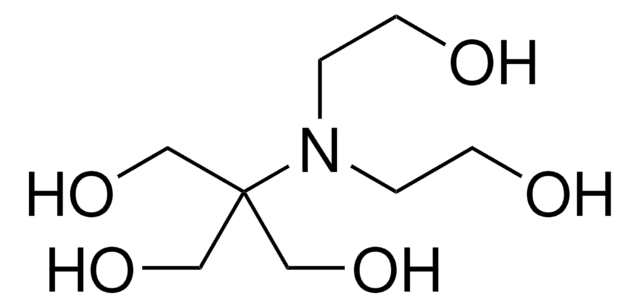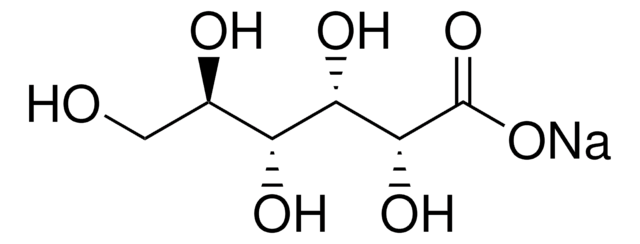Kluczowe dokumenty
T9784
Tricine
BioXtra, pH 4.0-6.0 (1 M in H2O), ≥99% (titration)
Synonim(y):
N-[Tris(hydroxymethyl)methyl]glycine
About This Item
Polecane produkty
linia produktu
BioXtra
Poziom jakości
Próba
≥99% (titration)
Formularz
powder
zanieczyszczenia
≤0.005% Phosphorus (P)
≤0.1% Insoluble matter
pozostałość po prażeniu
≤0.1%
pH
4.0-6.0 (1 M in H2O)
przydatny zakres pH
7.4-8.8
pKa (25°C)
8.1
rozpuszczalność
H2O: 1 M, clear, colorless
ślady anionów
chloride (Cl-): ≤0.1%
sulfate (SO42-): ≤0.05%
ślady kationów
Al: ≤0.0005%
Ca: ≤0.0005%
Cu: ≤0.0005%
Fe: ≤0.0005%
K: ≤0.005%
Mg: ≤0.0005%
NH4+: ≤0.05%
Na: ≤0.005%
Pb: ≤0.001%
Zn: ≤0.0005%
Absorpcja
≤0.05 at 280 in H2O at 1 M
≤0.1 at 260 in H2O at 1 M
Zastosowanie
diagnostic assay manufacturing
ciąg SMILES
OCC(CO)(CO)NCC(O)=O
InChI
1S/C6H13NO5/c8-2-6(3-9,4-10)7-1-5(11)12/h7-10H,1-4H2,(H,11,12)
Klucz InChI
SEQKRHFRPICQDD-UHFFFAOYSA-N
Szukasz podobnych produktów? Odwiedź Przewodnik dotyczący porównywania produktów
Opis ogólny
Zastosowanie
- in a polymerase chain reaction (PCR) buffer used in the single-cell collection
- as a component of lactotroph feeding medium for culturing lactotrophs
- to prepare luciferase assay reagent for luciferase activity assay in firefly Photonis pyralis and as a component in Triton/glycylglycine lysis buffer
Nie możesz znaleźć właściwego produktu?
Wypróbuj nasz Narzędzie selektora produktów.
Kod klasy składowania
13 - Non Combustible Solids
Klasa zagrożenia wodnego (WGK)
WGK 3
Temperatura zapłonu (°F)
Not applicable
Temperatura zapłonu (°C)
Not applicable
Środki ochrony indywidualnej
Eyeshields, Gloves, type N95 (US)
Wybierz jedną z najnowszych wersji:
Masz już ten produkt?
Dokumenty związane z niedawno zakupionymi produktami zostały zamieszczone w Bibliotece dokumentów.
Klienci oglądali również te produkty
Nasz zespół naukowców ma doświadczenie we wszystkich obszarach badań, w tym w naukach przyrodniczych, materiałoznawstwie, syntezie chemicznej, chromatografii, analityce i wielu innych dziedzinach.
Skontaktuj się z zespołem ds. pomocy technicznej





